Chain of Custody Letter Template Guide
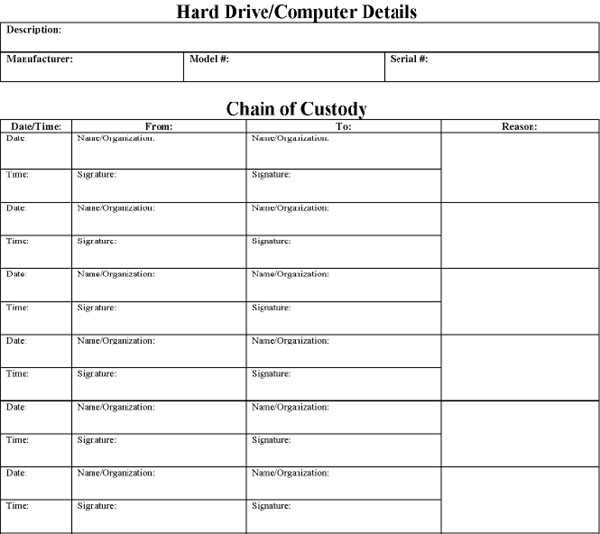
Proper documentation of evidence transfer and management is essential in maintaining its integrity throughout legal processes. This documentation ensures that items are handled securely and tracked accurately, from collection to presentation in court. A well-organized record provides transparency and accountability, which are crucial in safeguarding the authenticity of evidence.
Creating a detailed account of each step in the process helps avoid disputes and confirms that no tampering or mishandling occurred. Whether for criminal investigations, civil cases, or any legal proceedings involving physical items, clear documentation is necessary for both legal compliance and effective case management.
What is a Document for Evidence Handling
In legal proceedings, a formal document is used to record the movement and control of physical evidence. This document serves as an official record, ensuring that all parties involved have a clear understanding of who has possessed or handled the items at each stage of the process. It plays a critical role in confirming the integrity of the evidence throughout its journey from collection to court submission.
Purpose and Importance
The main purpose of this document is to provide a transparent and traceable history of evidence. It outlines the individuals responsible for each transfer, along with timestamps, which prevents any potential claims of tampering or mishandling. By maintaining a comprehensive record, the document helps establish the credibility of the evidence in legal proceedings.
Key Features
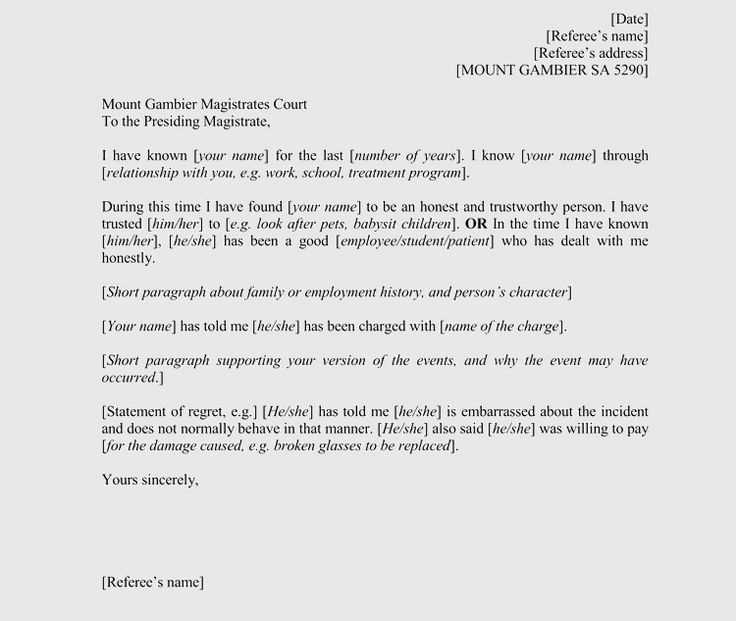
Essential elements of this document include the identification of the item, the dates and times of transfers, and the names of individuals handling the item. The document also typically contains signatures to verify the legitimacy of each action taken. These details create a reliable chain that demonstrates the secure handling of the evidence at every stage.
Essential Information to Include in the Document
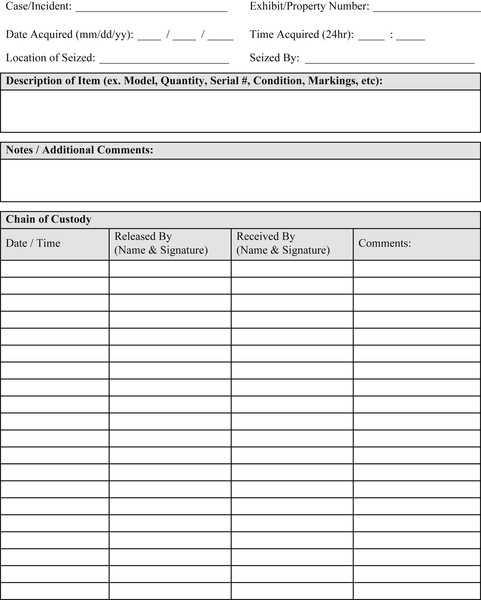
For a document that tracks the handling and movement of evidence, it is crucial to include specific details that ensure its integrity and reliability. These elements form the backbone of the record, allowing all parties involved to verify that the evidence has been properly handled and that no tampering or errors have occurred throughout its lifecycle.
Key details to include are the description of the evidence, such as its type, condition, and unique identifiers. Additionally, the names and signatures of individuals responsible for the evidence at each stage are necessary. Dates and times of each transfer or handling event should be documented as well, providing an accurate timeline of the evidence’s movement. Finally, clear instructions regarding storage locations and handling protocols can further ensure the evidence remains secure and accounted for at all times.
Steps for Writing an Evidence Handling Document
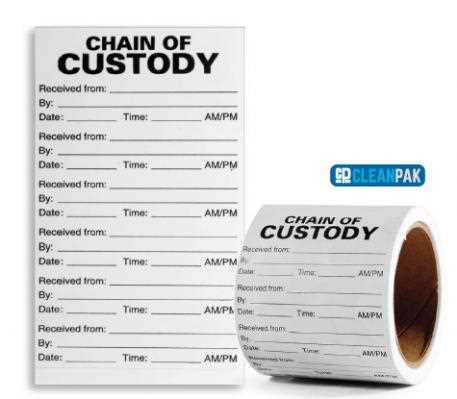
Creating a document that tracks the transfer and control of evidence requires a clear and structured approach. Each step should be documented carefully to ensure transparency and legal compliance. The goal is to provide a detailed, reliable record that confirms the proper handling of the evidence throughout the process.
Begin with Clear Identification
The first step is to accurately identify the item. This includes a description, serial number (if applicable), and any distinguishing features. The more specific the details, the easier it is to avoid confusion or disputes about the evidence in the future. Ensuring that the evidence is properly labeled from the start is critical for maintaining its integrity.
Record Each Transfer and Handling
Next, document every instance of handling or transfer. For each event, include the name of the individual responsible, the date and time, and the reason for the transfer. Signatures from both the person transferring and the person receiving the item add further credibility to the record. These entries create a reliable trail of accountability, ensuring that no step in the process is overlooked.
Why Accurate Documentation is Crucial
Accurate documentation of evidence handling is vital in any legal process. Without precise records, it becomes difficult to establish the integrity of the items involved, potentially jeopardizing the entire case. Proper documentation provides clarity, accountability, and transparency, ensuring that all actions related to the evidence are verifiable and legitimate.
Here are some key reasons why thorough and correct documentation is essential:
- Prevents Tampering Claims: Clear records help demonstrate that evidence has been handled properly, reducing the risk of accusations of manipulation or tampering.
- Establishes Accountability: Every person who handles or transfers the evidence is identified, ensuring that responsibility can be traced at all stages.
- Ensures Legal Compliance: Accurate records are often required by law, making them essential for compliance with legal standards and regulations.
- Supports Case Integrity: Well-maintained records contribute to the overall credibility of the case, reinforcing the validity of the evidence presented.
In short, maintaining precise documentation is essential for protecting the chain of events and safeguarding the evidence from potential challenges in the future.
How Evidence Handling Affects Legal Cases
In legal proceedings, the way evidence is documented, transferred, and managed plays a critical role in determining the outcome of a case. Properly maintained records ensure that the evidence remains intact and reliable, supporting the case’s validity in court. If any discrepancies or doubts arise regarding the handling of the evidence, it can lead to serious consequences, such as the dismissal of key items or the weakening of the case.
One of the most significant impacts of improper documentation is the risk of evidence being considered inadmissible. Without a clear and traceable record of its handling, the evidence may be questioned by opposing parties or the court itself. This can lead to:
- Loss of Credibility: The authenticity of the evidence could be challenged, diminishing its value in proving a point in the case.
- Legal Disputes: Any inconsistency or missing information could lead to disputes that delay the proceedings or result in the evidence being excluded.
- Weakened Defense or Prosecution: Inaccurate documentation can severely undermine the strength of either side’s argument, leading to unfavorable judgments.
Accurate and thorough handling documentation is crucial for maintaining the integrity of evidence and ensuring that it serves its purpose in legal cases.
Tips for Properly Managing Evidence
Proper management of evidence is essential to ensure its integrity and reliability throughout the legal process. From collection to storage, each step must be handled with precision to prevent contamination, loss, or tampering. By following key practices, individuals can maintain the authenticity of the evidence and avoid challenges to its validity in court.
Ensure Detailed Documentation
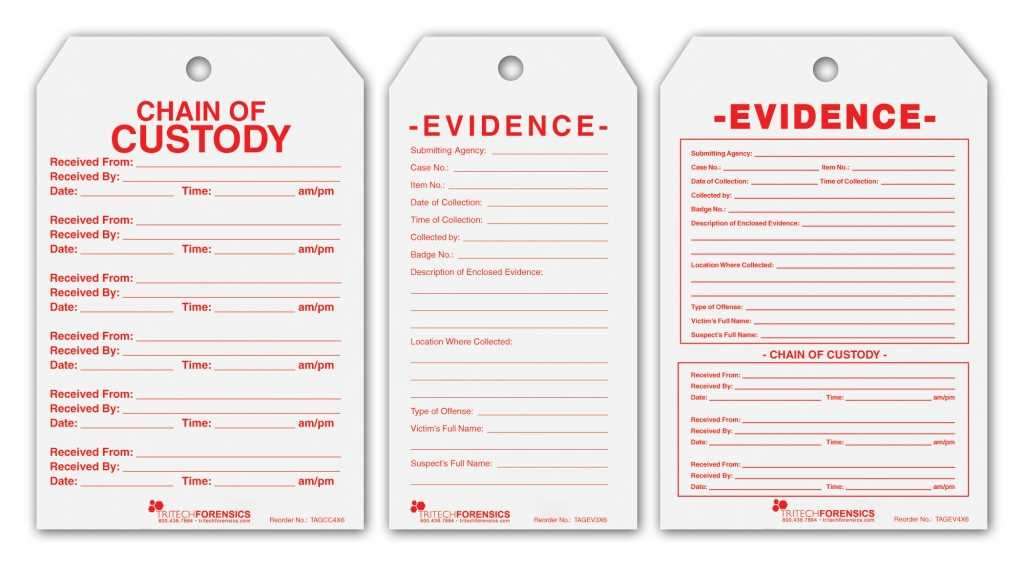
Accurate records are vital for tracking the movement and handling of items. Every interaction with the evidence should be logged with specific details, including dates, times, and the names of individuals involved. This creates a verifiable trail that can be referenced if questions arise later. Consistent documentation reduces the risk of errors and strengthens the case’s credibility.
Follow Strict Storage Protocols
Evidence should be stored in secure locations to minimize the risk of tampering or damage. Lockboxes, evidence rooms, or secure facilities are ideal for keeping items safe. Proper labeling, as well as maintaining separation between different pieces of evidence, is essential for clarity and control. Additionally, ensure that access to the storage area is restricted to authorized personnel only.
Remember: Proper management requires discipline and attention to detail. Following these guidelines helps ensure that evidence remains unaltered and its chain of handling is preserved.